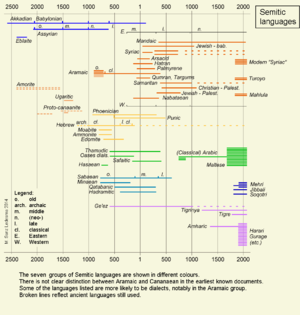Semitic scholar
| Semitic | |
|---|---|
| Syro-Arabian | |
| Geographic distribution |
Western Asia, North Africa, Northeast Africa, Malta |
| Linguistic classification |
Afro-Asiatic
|
| Proto-language | Proto-Semitic |
| Subdivisions | |
| ISO 639-2 / 5 | |
| Glottolog | semi1276 |

Chronology mapping of Semitic languages
|
|
The Semitic languages are a branch of the Afroasiatic language family originating in the Middle East. Semitic languages are spoken by more than 330 million people across much of Western Asia, North Africa and the Horn of Africa, as well as in often large expatriate communities in North America and Europe, with smaller communities in the Caucasus and Central Asia. The terminology was first used in the 1780s by members of the Göttingen School of History, who derived the name from Shem, one of the three sons of Noah in the Book of Genesis.
The most widely spoken Semitic languages today are (numbers given are for native speakers only) Arabic (300 million),Amharic (22 million),Tigrinya (7 million),Hebrew (unknown; 5 million native and non-native L1 speakers),Tigre (~1.05), Aramaic (575,000 to 1 million largely Assyrian fluent speakers) and Maltese (520,000 speakers).
Semitic languages occur in written form from a very early historical date, with East Semitic Akkadian and Eblaite texts (written in a script adapted from Sumerian cuneiform) appearing from the 29th century BCE and the 25th century BCE in Mesopotamia and the northern Levant respectively. The only earlier attested languages are Sumerian, Elamite (both language isolates), Egyptian and unclassified Lullubi. However, most scripts used to write Semitic languages are abjads – a type of alphabetic script that omits some or all of the vowels, which is feasible for these languages because the consonants in the Semitic languages are the primary carriers of meaning.
...
Wikipedia
